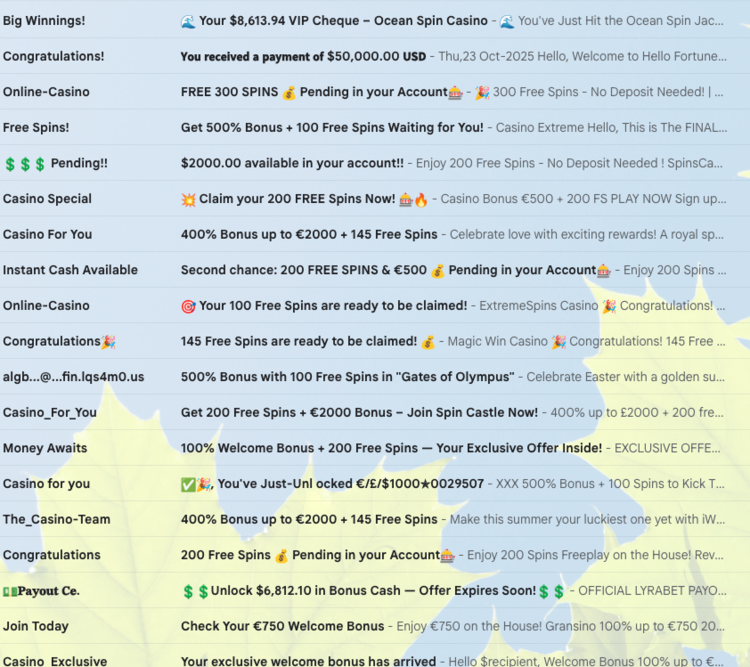Why Did My Email Bounce? Understanding Spam Filters and How to Fix the Problem
October 23rd 2025

It’s frustrating when an email bounces. You send a message, wait for a reply, and later find out it never arrived - or worse, that it was rejected as spam. Email deliverability problems are common and can happen to anyone, even when both sides are using reputable email services. At SilverServers, we often help clients identify why emails fail to arrive and how to prevent it from happening again. The most common cause? Spam filters doing exactly what they’re designed to do.
What a “Bounce” Really Means
When you send an email, it travels from your mail server to the recipient’s. If the recipient’s server refuses it for any reason, your mail service generates a “bounce” message — a notice that delivery failed. There are two main types:
- Soft bounce: Temporary issue (mailbox full, server busy, or message too large).
- Hard bounce: Permanent issue (invalid address, or blocked by policy or spam filter).
If an address is valid and the message still bounces, it’s usually because a spam filter rejected it.
What Spam Filters Do
Spam filters analyze every incoming email to decide whether to accept, quarantine, or reject it. Their goal is to block unwanted or malicious messages before they reach an inbox. Filters use many signals to decide:
- Reputation of the sending server or domain (based on global spam lists)
- Authentication records (SPF, DKIM, DMARC)
- Content (spam-like wording, too many links, large attachments)
- User behavior (recipients frequently mark similar emails as spam)
If the message triggers one or more of these rules, the receiving mail system may silently discard it or return a bounce notice.
How to Tell When Spam Filtering Is the Cause
You can usually identify a spam-related bounce by looking at the error message in the delivery failure notice. Common examples include:
- “550 Message rejected due to spam content”
- “554 5.7.1 Message refused by policy”
- “Message rejected – listed on spamhaus.org or other RBL”
Sometimes the sender won’t see an error at all — the recipient’s system may accept the message but move it to a junk or quarantine folder. If this happens repeatedly with a specific contact, it’s likely a filtering or reputation issue, not a configuration error.
What Receivers Can Do
If you trust a sender but their emails are being filtered or bounced:
- Whitelist them. Add their address or domain (e.g. @company.com) to your email program’s safe-sender list or approved contacts.
- Check your spam or quarantine folder. Mark legitimate messages as “Not Spam” to train your filter.
- Review any custom rules. Filters that target certain words, attachments, or senders can accidentally catch real emails.
- Ask your IT provider to check the server logs. They can confirm if the messages were rejected before reaching your inbox.
What Senders Can Do
If your emails are bouncing or landing in spam folders, it’s worth investigating your domain’s email reputation. You can have your IT support team take a look, or you can do it yourself if you’re comfortable. Here’s how to improve it:
Authenticate your domain. Make sure SPF, DKIM, and DMARC records are properly set up. These prove your emails are legitimate.
Avoid spammy language. Overuse of sales terms, links, or attachments can raise flags.
Use consistent sending patterns. Sudden spikes in email volume can trigger reputation systems.
Monitor blocklists. Use public tools to see if your domain or IP is listed. Examples include:
- Spamhaus Blocklist Removal Center
- MXToolbox Blacklist Check
- Barracuda Reputation Lookup
- MultiRBL Blacklist Check
- If your domain or mail server IP appears on any of these, follow that site’s delisting instructions.
Encourage engagement. When recipients open and reply to your messages, filters learn that your emails are wanted.
Reputation issues can take time to correct, but consistency and clean sending habits usually restore normal delivery.
Why These Problems Happen
Spam filtering is automated and constantly evolving. Lists and algorithms update daily based on new threats. Sometimes, legitimate businesses are caught in the crossfire — especially if they share mail infrastructure with others who have poor sending habits, or if a recipient’s system has overly strict rules. That’s why troubleshooting email deliverability requires looking at both sides: sender reputation and receiver settings.
Keeping Communication Flowing
No one can eliminate all bounce risks, but good maintenance keeps communication reliable. Maintain accurate contact lists, send authenticated messages, train filters through consistent interaction, and check your domain’s email health periodically. Understanding how spam filters work — and how to work with them — is the simplest way to make sure messages go where they’re meant to.
Need help diagnosing a bounce or reputation issue? Get in touch with your email support team. They’ll help you identify whether the problem is on the sending side, the receiving side, or somewhere in between.
For related content, visit the email tips section of our blog


